Legal Analysis: Determining Julia's Employment Status under ERA 1996
VerifiedAdded on 2023/01/05
|9
|2816
|82
Essay
AI Summary
This essay analyzes the employment status of Julia, focusing on whether she is an employee or an independent contractor at the Portland Hotel, in light of the Employment Rights Act (ERA) 1996. The analysis begins by defining employment and differentiating between employees and independent contractors. It then examines the key provisions of the ERA 1996, including unfair dismissal, rights of notice, and redundancy. The essay applies various legal tests, such as the control test, integration test, mutuality of obligation test, and the multiple factor test, to determine Julia's employment status. The essay also discusses the implications of her employment status concerning her rights and protections under the ERA 1996, including the potential for unfair dismissal and available remedies. The conclusion is drawn based on the application of these tests to the facts of the case, with reference to relevant case law such as Walker vs. Crystal Palace Football Club and Carmichael v National Power Plc. The essay highlights how Julia's situation aligns with the characteristics of an employee, considering factors such as the degree of control exercised by the employer, the integration of her work within the hotel's operations, and the mutual obligations between her and the hotel.
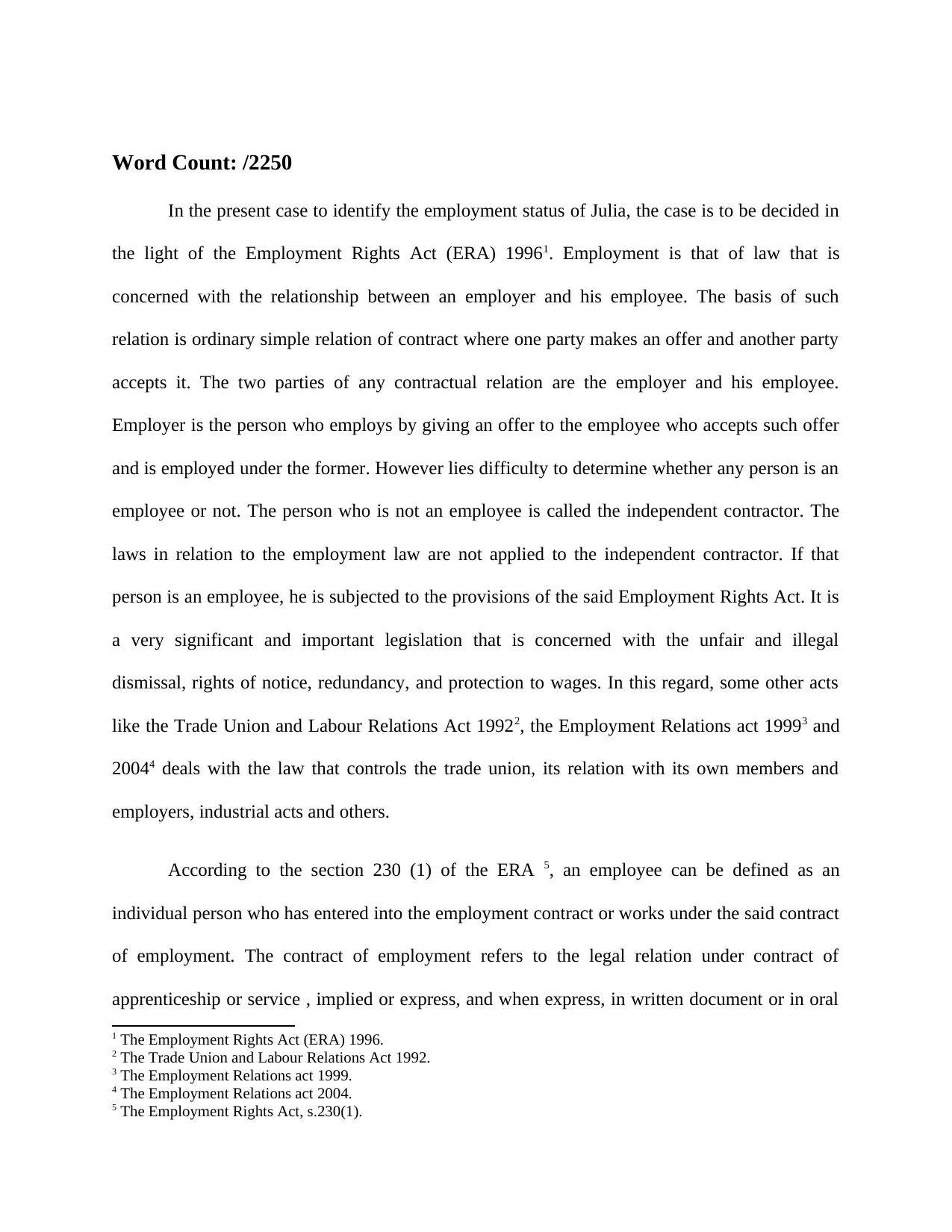
Word Count: /2250
In the present case to identify the employment status of Julia, the case is to be decided in
the light of the Employment Rights Act (ERA) 19961. Employment is that of law that is
concerned with the relationship between an employer and his employee. The basis of such
relation is ordinary simple relation of contract where one party makes an offer and another party
accepts it. The two parties of any contractual relation are the employer and his employee.
Employer is the person who employs by giving an offer to the employee who accepts such offer
and is employed under the former. However lies difficulty to determine whether any person is an
employee or not. The person who is not an employee is called the independent contractor. The
laws in relation to the employment law are not applied to the independent contractor. If that
person is an employee, he is subjected to the provisions of the said Employment Rights Act. It is
a very significant and important legislation that is concerned with the unfair and illegal
dismissal, rights of notice, redundancy, and protection to wages. In this regard, some other acts
like the Trade Union and Labour Relations Act 19922, the Employment Relations act 19993 and
20044 deals with the law that controls the trade union, its relation with its own members and
employers, industrial acts and others.
According to the section 230 (1) of the ERA 5, an employee can be defined as an
individual person who has entered into the employment contract or works under the said contract
of employment. The contract of employment refers to the legal relation under contract of
apprenticeship or service , implied or express, and when express, in written document or in oral
1 The Employment Rights Act (ERA) 1996.
2 The Trade Union and Labour Relations Act 1992.
3 The Employment Relations act 1999.
4 The Employment Relations act 2004.
5 The Employment Rights Act, s.230(1).
In the present case to identify the employment status of Julia, the case is to be decided in
the light of the Employment Rights Act (ERA) 19961. Employment is that of law that is
concerned with the relationship between an employer and his employee. The basis of such
relation is ordinary simple relation of contract where one party makes an offer and another party
accepts it. The two parties of any contractual relation are the employer and his employee.
Employer is the person who employs by giving an offer to the employee who accepts such offer
and is employed under the former. However lies difficulty to determine whether any person is an
employee or not. The person who is not an employee is called the independent contractor. The
laws in relation to the employment law are not applied to the independent contractor. If that
person is an employee, he is subjected to the provisions of the said Employment Rights Act. It is
a very significant and important legislation that is concerned with the unfair and illegal
dismissal, rights of notice, redundancy, and protection to wages. In this regard, some other acts
like the Trade Union and Labour Relations Act 19922, the Employment Relations act 19993 and
20044 deals with the law that controls the trade union, its relation with its own members and
employers, industrial acts and others.
According to the section 230 (1) of the ERA 5, an employee can be defined as an
individual person who has entered into the employment contract or works under the said contract
of employment. The contract of employment refers to the legal relation under contract of
apprenticeship or service , implied or express, and when express, in written document or in oral
1 The Employment Rights Act (ERA) 1996.
2 The Trade Union and Labour Relations Act 1992.
3 The Employment Relations act 1999.
4 The Employment Relations act 2004.
5 The Employment Rights Act, s.230(1).
Paraphrase This Document
Need a fresh take? Get an instant paraphrase of this document with our AI Paraphraser
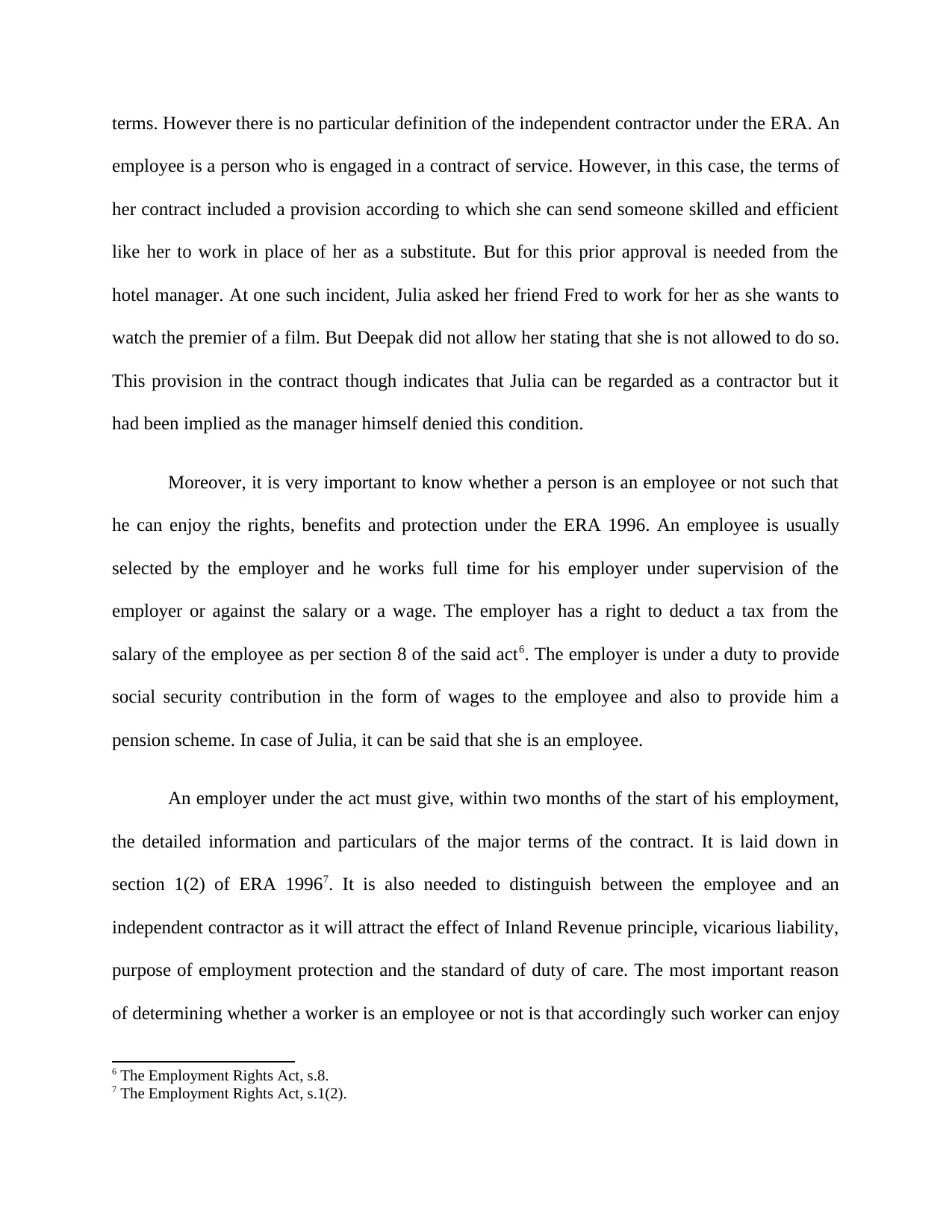
terms. However there is no particular definition of the independent contractor under the ERA. An
employee is a person who is engaged in a contract of service. However, in this case, the terms of
her contract included a provision according to which she can send someone skilled and efficient
like her to work in place of her as a substitute. But for this prior approval is needed from the
hotel manager. At one such incident, Julia asked her friend Fred to work for her as she wants to
watch the premier of a film. But Deepak did not allow her stating that she is not allowed to do so.
This provision in the contract though indicates that Julia can be regarded as a contractor but it
had been implied as the manager himself denied this condition.
Moreover, it is very important to know whether a person is an employee or not such that
he can enjoy the rights, benefits and protection under the ERA 1996. An employee is usually
selected by the employer and he works full time for his employer under supervision of the
employer or against the salary or a wage. The employer has a right to deduct a tax from the
salary of the employee as per section 8 of the said act6. The employer is under a duty to provide
social security contribution in the form of wages to the employee and also to provide him a
pension scheme. In case of Julia, it can be said that she is an employee.
An employer under the act must give, within two months of the start of his employment,
the detailed information and particulars of the major terms of the contract. It is laid down in
section 1(2) of ERA 19967. It is also needed to distinguish between the employee and an
independent contractor as it will attract the effect of Inland Revenue principle, vicarious liability,
purpose of employment protection and the standard of duty of care. The most important reason
of determining whether a worker is an employee or not is that accordingly such worker can enjoy
6 The Employment Rights Act, s.8.
7 The Employment Rights Act, s.1(2).
employee is a person who is engaged in a contract of service. However, in this case, the terms of
her contract included a provision according to which she can send someone skilled and efficient
like her to work in place of her as a substitute. But for this prior approval is needed from the
hotel manager. At one such incident, Julia asked her friend Fred to work for her as she wants to
watch the premier of a film. But Deepak did not allow her stating that she is not allowed to do so.
This provision in the contract though indicates that Julia can be regarded as a contractor but it
had been implied as the manager himself denied this condition.
Moreover, it is very important to know whether a person is an employee or not such that
he can enjoy the rights, benefits and protection under the ERA 1996. An employee is usually
selected by the employer and he works full time for his employer under supervision of the
employer or against the salary or a wage. The employer has a right to deduct a tax from the
salary of the employee as per section 8 of the said act6. The employer is under a duty to provide
social security contribution in the form of wages to the employee and also to provide him a
pension scheme. In case of Julia, it can be said that she is an employee.
An employer under the act must give, within two months of the start of his employment,
the detailed information and particulars of the major terms of the contract. It is laid down in
section 1(2) of ERA 19967. It is also needed to distinguish between the employee and an
independent contractor as it will attract the effect of Inland Revenue principle, vicarious liability,
purpose of employment protection and the standard of duty of care. The most important reason
of determining whether a worker is an employee or not is that accordingly such worker can enjoy
6 The Employment Rights Act, s.8.
7 The Employment Rights Act, s.1(2).
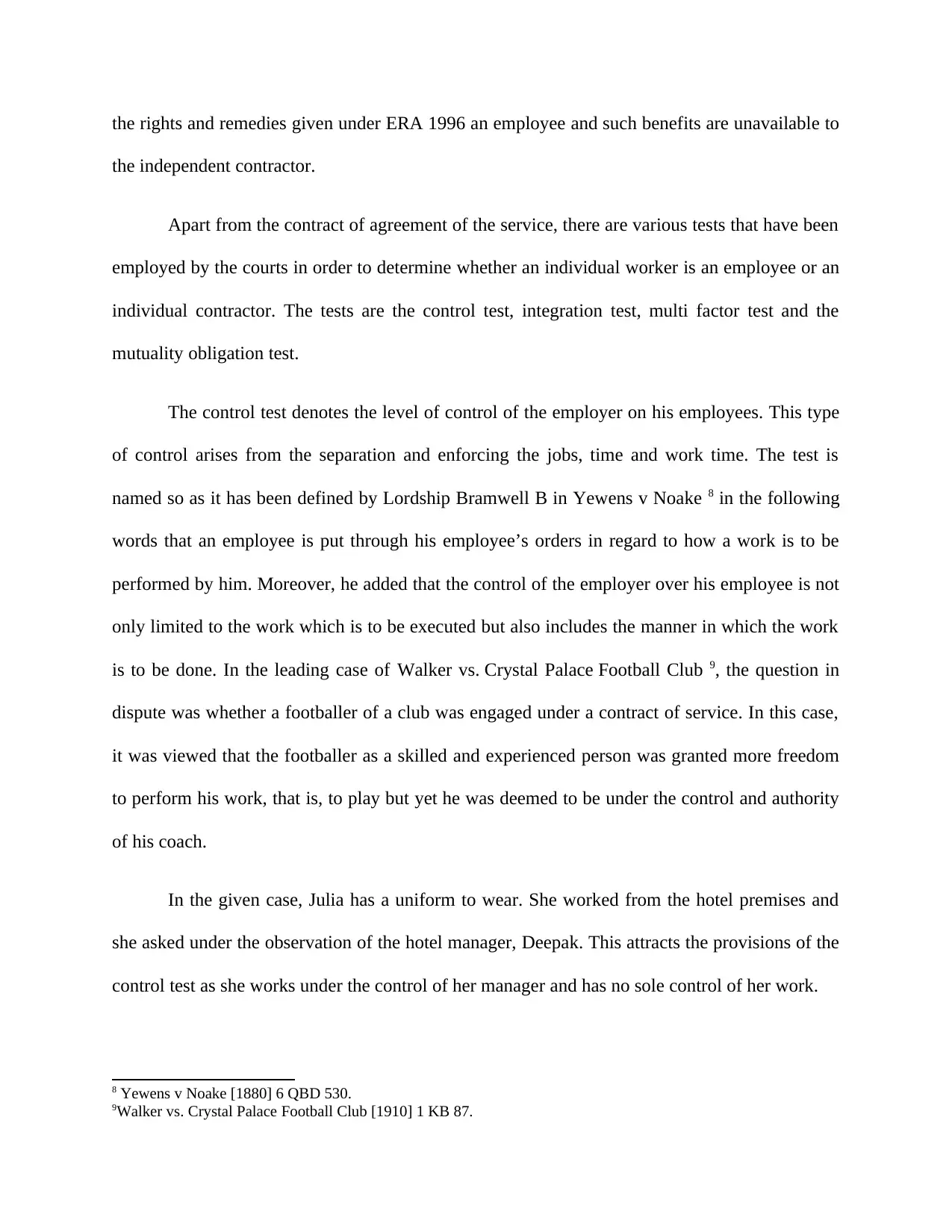
the rights and remedies given under ERA 1996 an employee and such benefits are unavailable to
the independent contractor.
Apart from the contract of agreement of the service, there are various tests that have been
employed by the courts in order to determine whether an individual worker is an employee or an
individual contractor. The tests are the control test, integration test, multi factor test and the
mutuality obligation test.
The control test denotes the level of control of the employer on his employees. This type
of control arises from the separation and enforcing the jobs, time and work time. The test is
named so as it has been defined by Lordship Bramwell B in Yewens v Noake 8 in the following
words that an employee is put through his employee’s orders in regard to how a work is to be
performed by him. Moreover, he added that the control of the employer over his employee is not
only limited to the work which is to be executed but also includes the manner in which the work
is to be done. In the leading case of Walker vs. Crystal Palace Football Club 9, the question in
dispute was whether a footballer of a club was engaged under a contract of service. In this case,
it was viewed that the footballer as a skilled and experienced person was granted more freedom
to perform his work, that is, to play but yet he was deemed to be under the control and authority
of his coach.
In the given case, Julia has a uniform to wear. She worked from the hotel premises and
she asked under the observation of the hotel manager, Deepak. This attracts the provisions of the
control test as she works under the control of her manager and has no sole control of her work.
8 Yewens v Noake [1880] 6 QBD 530.
9Walker vs. Crystal Palace Football Club [1910] 1 KB 87.
the independent contractor.
Apart from the contract of agreement of the service, there are various tests that have been
employed by the courts in order to determine whether an individual worker is an employee or an
individual contractor. The tests are the control test, integration test, multi factor test and the
mutuality obligation test.
The control test denotes the level of control of the employer on his employees. This type
of control arises from the separation and enforcing the jobs, time and work time. The test is
named so as it has been defined by Lordship Bramwell B in Yewens v Noake 8 in the following
words that an employee is put through his employee’s orders in regard to how a work is to be
performed by him. Moreover, he added that the control of the employer over his employee is not
only limited to the work which is to be executed but also includes the manner in which the work
is to be done. In the leading case of Walker vs. Crystal Palace Football Club 9, the question in
dispute was whether a footballer of a club was engaged under a contract of service. In this case,
it was viewed that the footballer as a skilled and experienced person was granted more freedom
to perform his work, that is, to play but yet he was deemed to be under the control and authority
of his coach.
In the given case, Julia has a uniform to wear. She worked from the hotel premises and
she asked under the observation of the hotel manager, Deepak. This attracts the provisions of the
control test as she works under the control of her manager and has no sole control of her work.
8 Yewens v Noake [1880] 6 QBD 530.
9Walker vs. Crystal Palace Football Club [1910] 1 KB 87.
⊘ This is a preview!⊘
Do you want full access?
Subscribe today to unlock all pages.

Trusted by 1+ million students worldwide
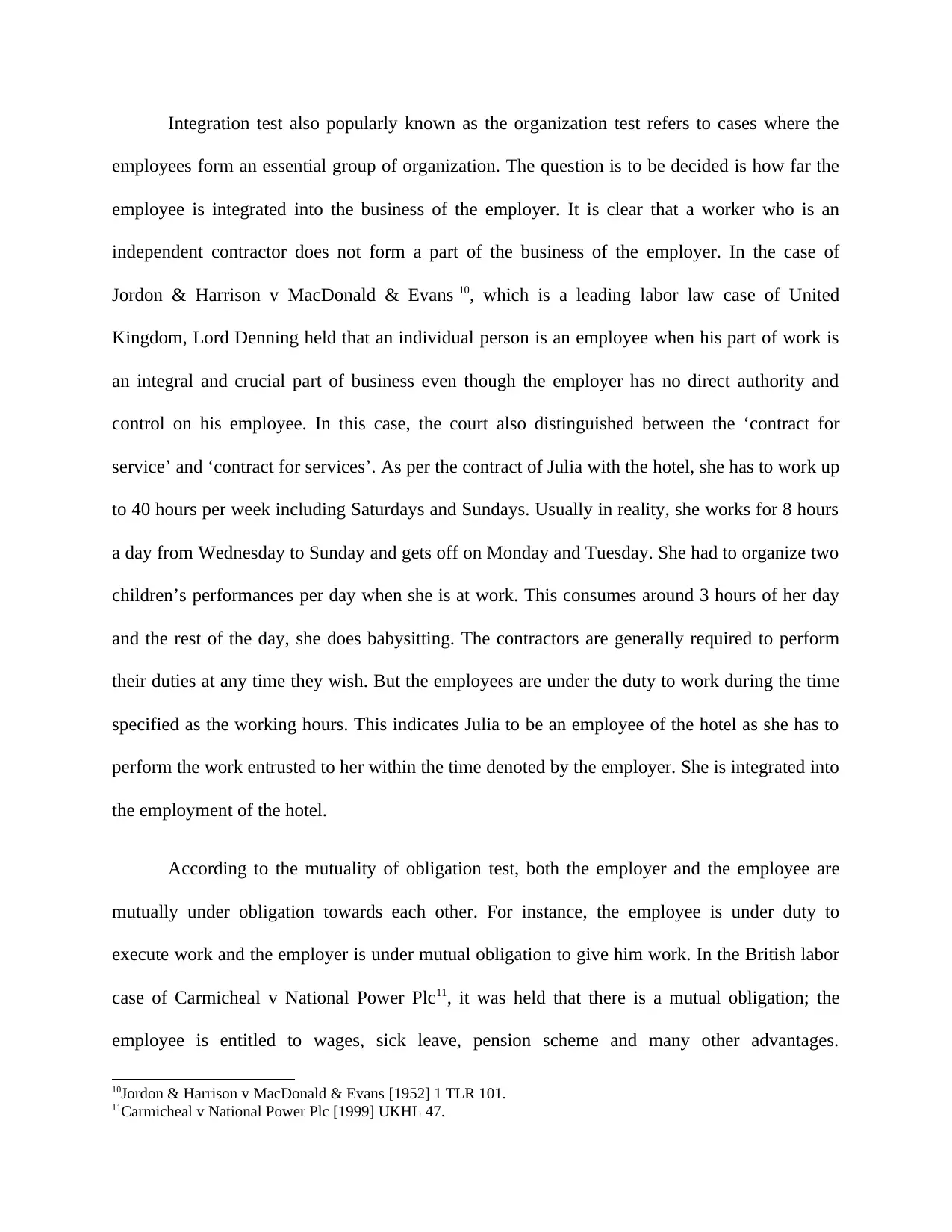
Integration test also popularly known as the organization test refers to cases where the
employees form an essential group of organization. The question is to be decided is how far the
employee is integrated into the business of the employer. It is clear that a worker who is an
independent contractor does not form a part of the business of the employer. In the case of
Jordon & Harrison v MacDonald & Evans 10, which is a leading labor law case of United
Kingdom, Lord Denning held that an individual person is an employee when his part of work is
an integral and crucial part of business even though the employer has no direct authority and
control on his employee. In this case, the court also distinguished between the ‘contract for
service’ and ‘contract for services’. As per the contract of Julia with the hotel, she has to work up
to 40 hours per week including Saturdays and Sundays. Usually in reality, she works for 8 hours
a day from Wednesday to Sunday and gets off on Monday and Tuesday. She had to organize two
children’s performances per day when she is at work. This consumes around 3 hours of her day
and the rest of the day, she does babysitting. The contractors are generally required to perform
their duties at any time they wish. But the employees are under the duty to work during the time
specified as the working hours. This indicates Julia to be an employee of the hotel as she has to
perform the work entrusted to her within the time denoted by the employer. She is integrated into
the employment of the hotel.
According to the mutuality of obligation test, both the employer and the employee are
mutually under obligation towards each other. For instance, the employee is under duty to
execute work and the employer is under mutual obligation to give him work. In the British labor
case of Carmicheal v National Power Plc11, it was held that there is a mutual obligation; the
employee is entitled to wages, sick leave, pension scheme and many other advantages.
10Jordon & Harrison v MacDonald & Evans [1952] 1 TLR 101.
11Carmicheal v National Power Plc [1999] UKHL 47.
employees form an essential group of organization. The question is to be decided is how far the
employee is integrated into the business of the employer. It is clear that a worker who is an
independent contractor does not form a part of the business of the employer. In the case of
Jordon & Harrison v MacDonald & Evans 10, which is a leading labor law case of United
Kingdom, Lord Denning held that an individual person is an employee when his part of work is
an integral and crucial part of business even though the employer has no direct authority and
control on his employee. In this case, the court also distinguished between the ‘contract for
service’ and ‘contract for services’. As per the contract of Julia with the hotel, she has to work up
to 40 hours per week including Saturdays and Sundays. Usually in reality, she works for 8 hours
a day from Wednesday to Sunday and gets off on Monday and Tuesday. She had to organize two
children’s performances per day when she is at work. This consumes around 3 hours of her day
and the rest of the day, she does babysitting. The contractors are generally required to perform
their duties at any time they wish. But the employees are under the duty to work during the time
specified as the working hours. This indicates Julia to be an employee of the hotel as she has to
perform the work entrusted to her within the time denoted by the employer. She is integrated into
the employment of the hotel.
According to the mutuality of obligation test, both the employer and the employee are
mutually under obligation towards each other. For instance, the employee is under duty to
execute work and the employer is under mutual obligation to give him work. In the British labor
case of Carmicheal v National Power Plc11, it was held that there is a mutual obligation; the
employee is entitled to wages, sick leave, pension scheme and many other advantages.
10Jordon & Harrison v MacDonald & Evans [1952] 1 TLR 101.
11Carmicheal v National Power Plc [1999] UKHL 47.
Paraphrase This Document
Need a fresh take? Get an instant paraphrase of this document with our AI Paraphraser
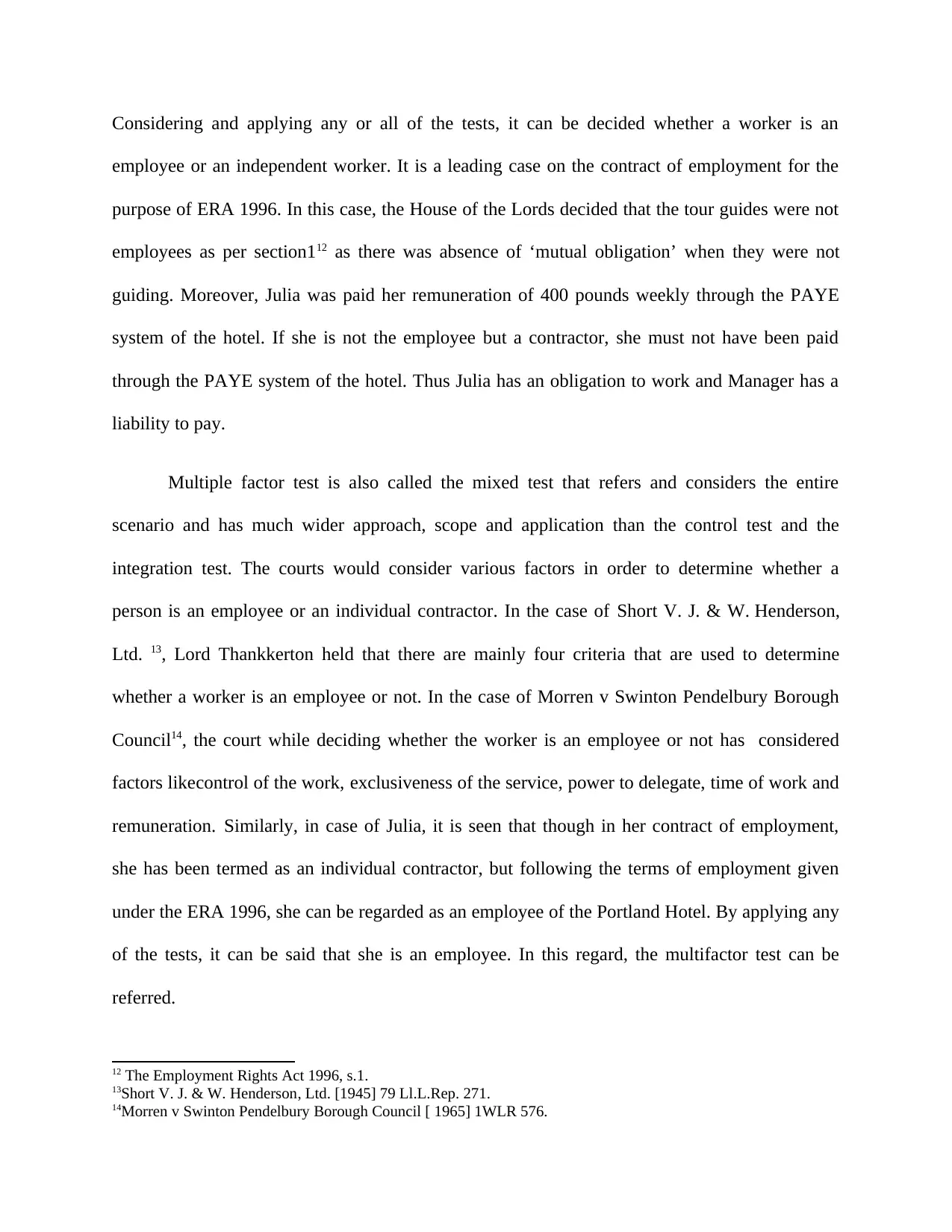
Considering and applying any or all of the tests, it can be decided whether a worker is an
employee or an independent worker. It is a leading case on the contract of employment for the
purpose of ERA 1996. In this case, the House of the Lords decided that the tour guides were not
employees as per section112 as there was absence of ‘mutual obligation’ when they were not
guiding. Moreover, Julia was paid her remuneration of 400 pounds weekly through the PAYE
system of the hotel. If she is not the employee but a contractor, she must not have been paid
through the PAYE system of the hotel. Thus Julia has an obligation to work and Manager has a
liability to pay.
Multiple factor test is also called the mixed test that refers and considers the entire
scenario and has much wider approach, scope and application than the control test and the
integration test. The courts would consider various factors in order to determine whether a
person is an employee or an individual contractor. In the case of Short V. J. & W. Henderson,
Ltd. 13, Lord Thankkerton held that there are mainly four criteria that are used to determine
whether a worker is an employee or not. In the case of Morren v Swinton Pendelbury Borough
Council14, the court while deciding whether the worker is an employee or not has considered
factors likecontrol of the work, exclusiveness of the service, power to delegate, time of work and
remuneration. Similarly, in case of Julia, it is seen that though in her contract of employment,
she has been termed as an individual contractor, but following the terms of employment given
under the ERA 1996, she can be regarded as an employee of the Portland Hotel. By applying any
of the tests, it can be said that she is an employee. In this regard, the multifactor test can be
referred.
12 The Employment Rights Act 1996, s.1.
13Short V. J. & W. Henderson, Ltd. [1945] 79 Ll.L.Rep. 271.
14Morren v Swinton Pendelbury Borough Council [ 1965] 1WLR 576.
employee or an independent worker. It is a leading case on the contract of employment for the
purpose of ERA 1996. In this case, the House of the Lords decided that the tour guides were not
employees as per section112 as there was absence of ‘mutual obligation’ when they were not
guiding. Moreover, Julia was paid her remuneration of 400 pounds weekly through the PAYE
system of the hotel. If she is not the employee but a contractor, she must not have been paid
through the PAYE system of the hotel. Thus Julia has an obligation to work and Manager has a
liability to pay.
Multiple factor test is also called the mixed test that refers and considers the entire
scenario and has much wider approach, scope and application than the control test and the
integration test. The courts would consider various factors in order to determine whether a
person is an employee or an individual contractor. In the case of Short V. J. & W. Henderson,
Ltd. 13, Lord Thankkerton held that there are mainly four criteria that are used to determine
whether a worker is an employee or not. In the case of Morren v Swinton Pendelbury Borough
Council14, the court while deciding whether the worker is an employee or not has considered
factors likecontrol of the work, exclusiveness of the service, power to delegate, time of work and
remuneration. Similarly, in case of Julia, it is seen that though in her contract of employment,
she has been termed as an individual contractor, but following the terms of employment given
under the ERA 1996, she can be regarded as an employee of the Portland Hotel. By applying any
of the tests, it can be said that she is an employee. In this regard, the multifactor test can be
referred.
12 The Employment Rights Act 1996, s.1.
13Short V. J. & W. Henderson, Ltd. [1945] 79 Ll.L.Rep. 271.
14Morren v Swinton Pendelbury Borough Council [ 1965] 1WLR 576.
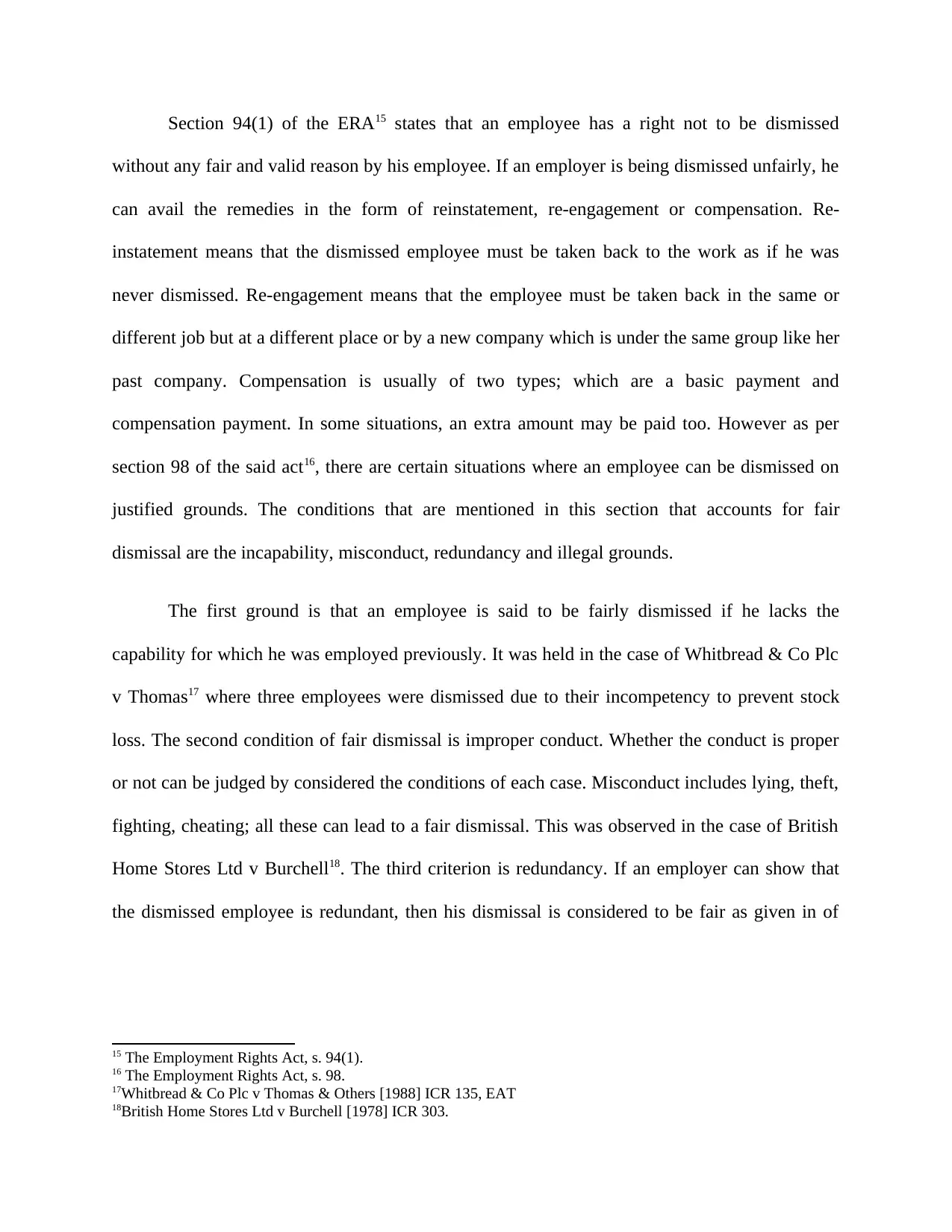
Section 94(1) of the ERA15 states that an employee has a right not to be dismissed
without any fair and valid reason by his employee. If an employer is being dismissed unfairly, he
can avail the remedies in the form of reinstatement, re-engagement or compensation. Re-
instatement means that the dismissed employee must be taken back to the work as if he was
never dismissed. Re-engagement means that the employee must be taken back in the same or
different job but at a different place or by a new company which is under the same group like her
past company. Compensation is usually of two types; which are a basic payment and
compensation payment. In some situations, an extra amount may be paid too. However as per
section 98 of the said act16, there are certain situations where an employee can be dismissed on
justified grounds. The conditions that are mentioned in this section that accounts for fair
dismissal are the incapability, misconduct, redundancy and illegal grounds.
The first ground is that an employee is said to be fairly dismissed if he lacks the
capability for which he was employed previously. It was held in the case of Whitbread & Co Plc
v Thomas17 where three employees were dismissed due to their incompetency to prevent stock
loss. The second condition of fair dismissal is improper conduct. Whether the conduct is proper
or not can be judged by considered the conditions of each case. Misconduct includes lying, theft,
fighting, cheating; all these can lead to a fair dismissal. This was observed in the case of British
Home Stores Ltd v Burchell18. The third criterion is redundancy. If an employer can show that
the dismissed employee is redundant, then his dismissal is considered to be fair as given in of
15 The Employment Rights Act, s. 94(1).
16 The Employment Rights Act, s. 98.
17Whitbread & Co Plc v Thomas & Others [1988] ICR 135, EAT
18British Home Stores Ltd v Burchell [1978] ICR 303.
without any fair and valid reason by his employee. If an employer is being dismissed unfairly, he
can avail the remedies in the form of reinstatement, re-engagement or compensation. Re-
instatement means that the dismissed employee must be taken back to the work as if he was
never dismissed. Re-engagement means that the employee must be taken back in the same or
different job but at a different place or by a new company which is under the same group like her
past company. Compensation is usually of two types; which are a basic payment and
compensation payment. In some situations, an extra amount may be paid too. However as per
section 98 of the said act16, there are certain situations where an employee can be dismissed on
justified grounds. The conditions that are mentioned in this section that accounts for fair
dismissal are the incapability, misconduct, redundancy and illegal grounds.
The first ground is that an employee is said to be fairly dismissed if he lacks the
capability for which he was employed previously. It was held in the case of Whitbread & Co Plc
v Thomas17 where three employees were dismissed due to their incompetency to prevent stock
loss. The second condition of fair dismissal is improper conduct. Whether the conduct is proper
or not can be judged by considered the conditions of each case. Misconduct includes lying, theft,
fighting, cheating; all these can lead to a fair dismissal. This was observed in the case of British
Home Stores Ltd v Burchell18. The third criterion is redundancy. If an employer can show that
the dismissed employee is redundant, then his dismissal is considered to be fair as given in of
15 The Employment Rights Act, s. 94(1).
16 The Employment Rights Act, s. 98.
17Whitbread & Co Plc v Thomas & Others [1988] ICR 135, EAT
18British Home Stores Ltd v Burchell [1978] ICR 303.
⊘ This is a preview!⊘
Do you want full access?
Subscribe today to unlock all pages.

Trusted by 1+ million students worldwide
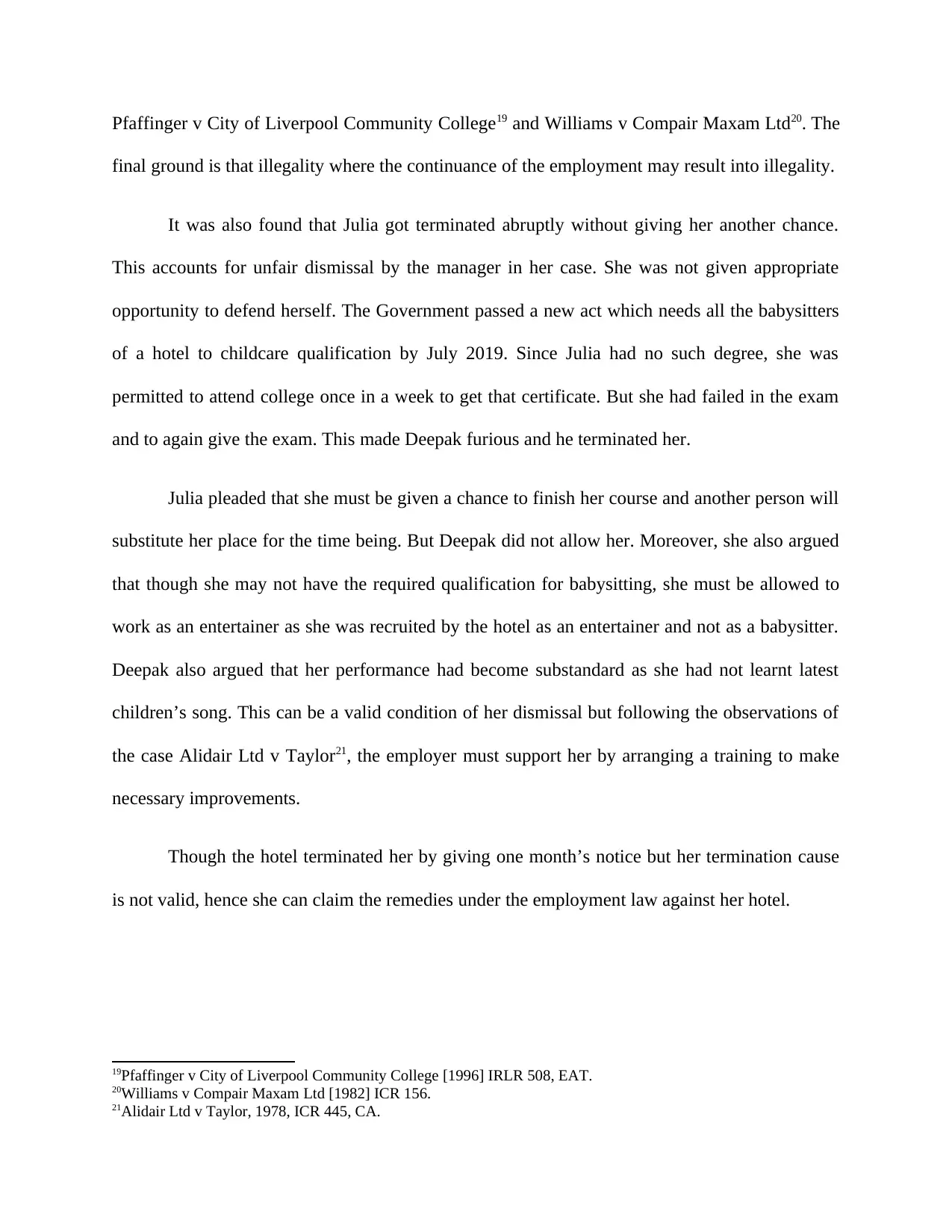
Pfaffinger v City of Liverpool Community College19 and Williams v Compair Maxam Ltd20. The
final ground is that illegality where the continuance of the employment may result into illegality.
It was also found that Julia got terminated abruptly without giving her another chance.
This accounts for unfair dismissal by the manager in her case. She was not given appropriate
opportunity to defend herself. The Government passed a new act which needs all the babysitters
of a hotel to childcare qualification by July 2019. Since Julia had no such degree, she was
permitted to attend college once in a week to get that certificate. But she had failed in the exam
and to again give the exam. This made Deepak furious and he terminated her.
Julia pleaded that she must be given a chance to finish her course and another person will
substitute her place for the time being. But Deepak did not allow her. Moreover, she also argued
that though she may not have the required qualification for babysitting, she must be allowed to
work as an entertainer as she was recruited by the hotel as an entertainer and not as a babysitter.
Deepak also argued that her performance had become substandard as she had not learnt latest
children’s song. This can be a valid condition of her dismissal but following the observations of
the case Alidair Ltd v Taylor21, the employer must support her by arranging a training to make
necessary improvements.
Though the hotel terminated her by giving one month’s notice but her termination cause
is not valid, hence she can claim the remedies under the employment law against her hotel.
19Pfaffinger v City of Liverpool Community College [1996] IRLR 508, EAT.
20Williams v Compair Maxam Ltd [1982] ICR 156.
21Alidair Ltd v Taylor, 1978, ICR 445, CA.
final ground is that illegality where the continuance of the employment may result into illegality.
It was also found that Julia got terminated abruptly without giving her another chance.
This accounts for unfair dismissal by the manager in her case. She was not given appropriate
opportunity to defend herself. The Government passed a new act which needs all the babysitters
of a hotel to childcare qualification by July 2019. Since Julia had no such degree, she was
permitted to attend college once in a week to get that certificate. But she had failed in the exam
and to again give the exam. This made Deepak furious and he terminated her.
Julia pleaded that she must be given a chance to finish her course and another person will
substitute her place for the time being. But Deepak did not allow her. Moreover, she also argued
that though she may not have the required qualification for babysitting, she must be allowed to
work as an entertainer as she was recruited by the hotel as an entertainer and not as a babysitter.
Deepak also argued that her performance had become substandard as she had not learnt latest
children’s song. This can be a valid condition of her dismissal but following the observations of
the case Alidair Ltd v Taylor21, the employer must support her by arranging a training to make
necessary improvements.
Though the hotel terminated her by giving one month’s notice but her termination cause
is not valid, hence she can claim the remedies under the employment law against her hotel.
19Pfaffinger v City of Liverpool Community College [1996] IRLR 508, EAT.
20Williams v Compair Maxam Ltd [1982] ICR 156.
21Alidair Ltd v Taylor, 1978, ICR 445, CA.
Paraphrase This Document
Need a fresh take? Get an instant paraphrase of this document with our AI Paraphraser
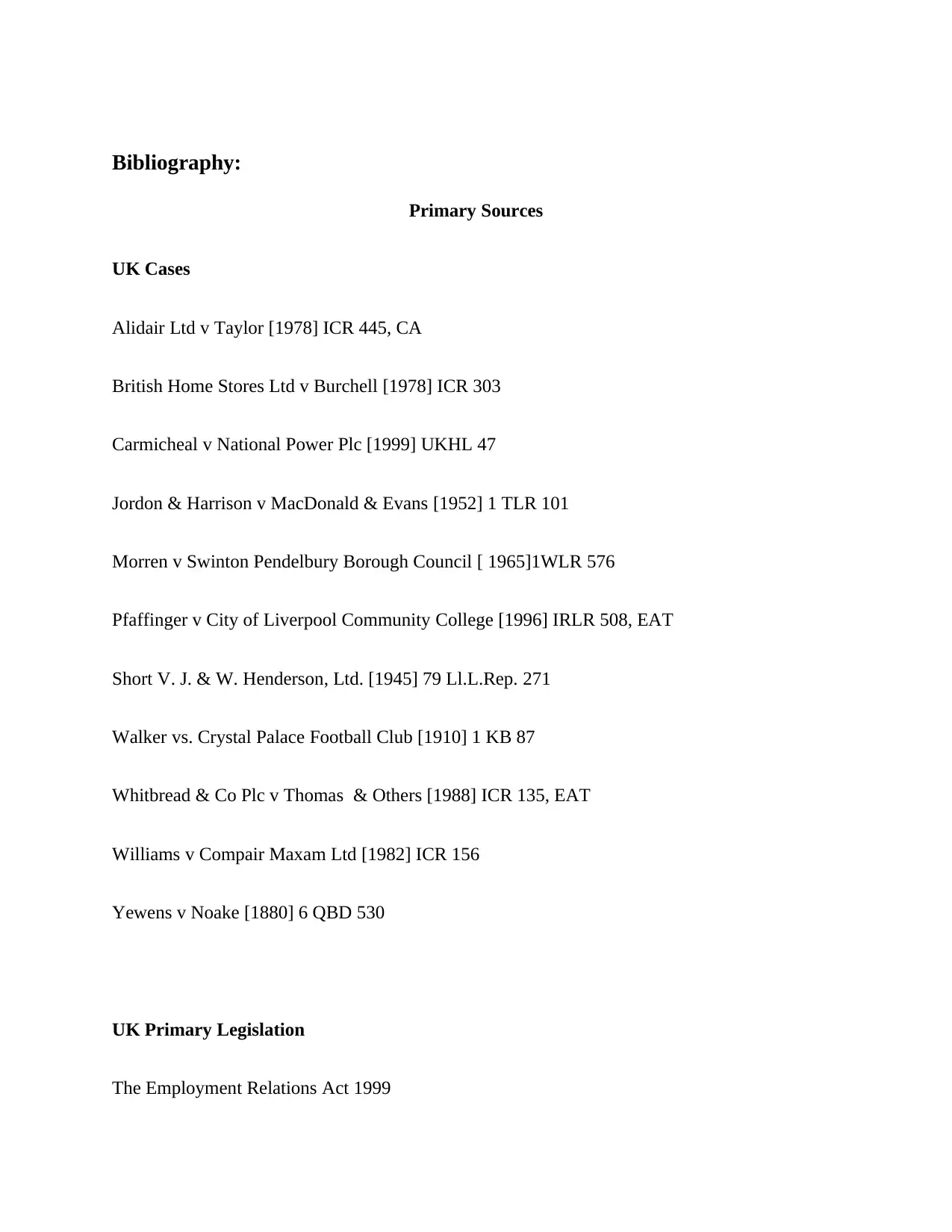
Bibliography:
Primary Sources
UK Cases
Alidair Ltd v Taylor [1978] ICR 445, CA
British Home Stores Ltd v Burchell [1978] ICR 303
Carmicheal v National Power Plc [1999] UKHL 47
Jordon & Harrison v MacDonald & Evans [1952] 1 TLR 101
Morren v Swinton Pendelbury Borough Council [ 1965]1WLR 576
Pfaffinger v City of Liverpool Community College [1996] IRLR 508, EAT
Short V. J. & W. Henderson, Ltd. [1945] 79 Ll.L.Rep. 271
Walker vs. Crystal Palace Football Club [1910] 1 KB 87
Whitbread & Co Plc v Thomas & Others [1988] ICR 135, EAT
Williams v Compair Maxam Ltd [1982] ICR 156
Yewens v Noake [1880] 6 QBD 530
UK Primary Legislation
The Employment Relations Act 1999
Primary Sources
UK Cases
Alidair Ltd v Taylor [1978] ICR 445, CA
British Home Stores Ltd v Burchell [1978] ICR 303
Carmicheal v National Power Plc [1999] UKHL 47
Jordon & Harrison v MacDonald & Evans [1952] 1 TLR 101
Morren v Swinton Pendelbury Borough Council [ 1965]1WLR 576
Pfaffinger v City of Liverpool Community College [1996] IRLR 508, EAT
Short V. J. & W. Henderson, Ltd. [1945] 79 Ll.L.Rep. 271
Walker vs. Crystal Palace Football Club [1910] 1 KB 87
Whitbread & Co Plc v Thomas & Others [1988] ICR 135, EAT
Williams v Compair Maxam Ltd [1982] ICR 156
Yewens v Noake [1880] 6 QBD 530
UK Primary Legislation
The Employment Relations Act 1999
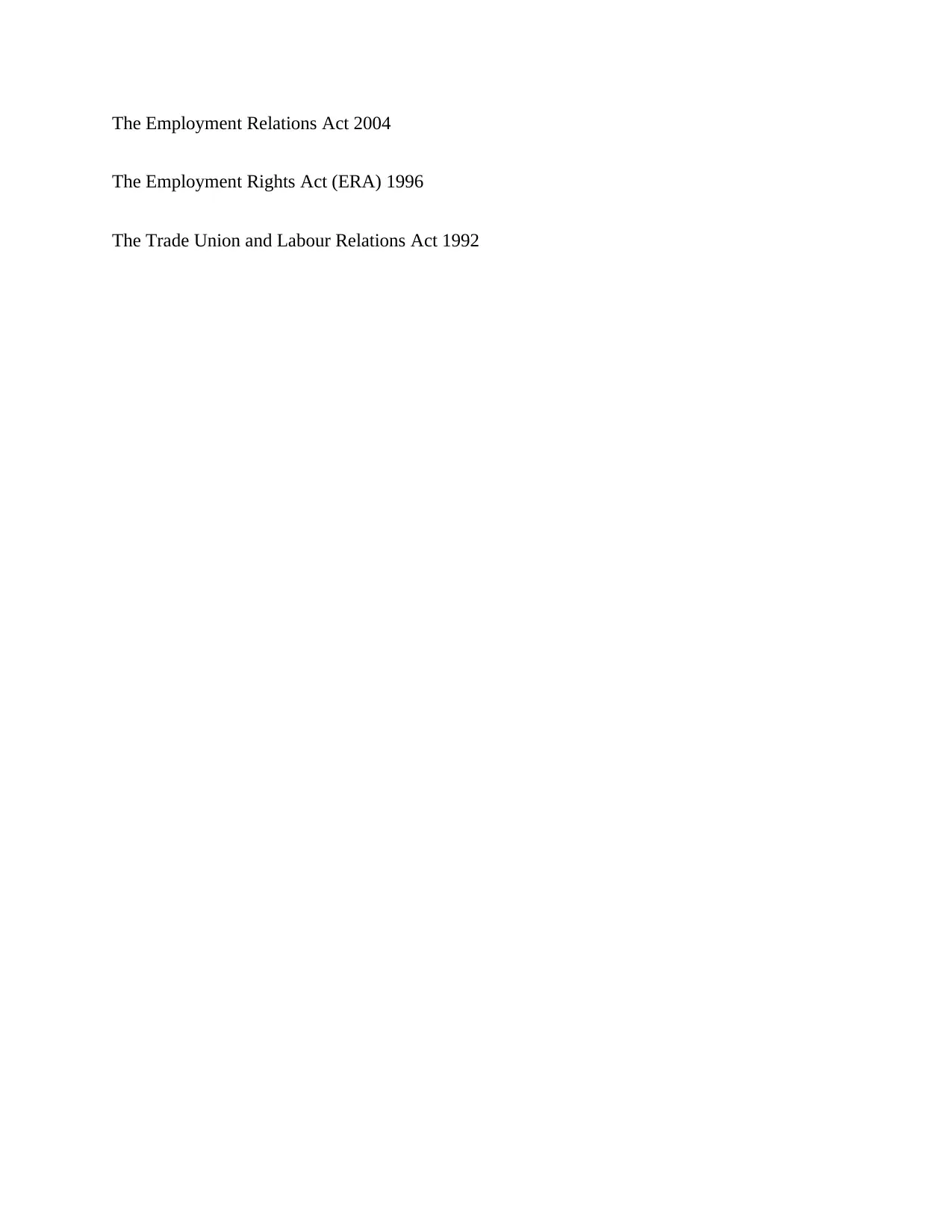
The Employment Relations Act 2004
The Employment Rights Act (ERA) 1996
The Trade Union and Labour Relations Act 1992
The Employment Rights Act (ERA) 1996
The Trade Union and Labour Relations Act 1992
⊘ This is a preview!⊘
Do you want full access?
Subscribe today to unlock all pages.

Trusted by 1+ million students worldwide
1 out of 9
Related Documents
Your All-in-One AI-Powered Toolkit for Academic Success.
+13062052269
info@desklib.com
Available 24*7 on WhatsApp / Email
![[object Object]](/_next/static/media/star-bottom.7253800d.svg)
Unlock your academic potential
Copyright © 2020–2025 A2Z Services. All Rights Reserved. Developed and managed by ZUCOL.





